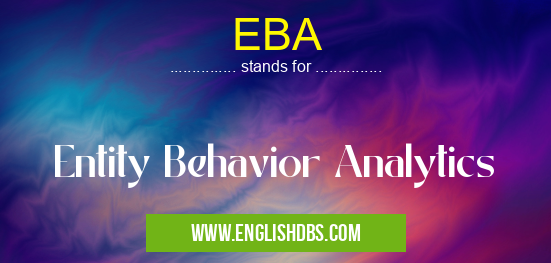What does EBA mean in UNCLASSIFIED
EBA stands for Entity Behavior Analytics. It is a form of data analysis that focuses on understanding the behavior of entities, such as individuals, organizations, or systems. EBA involves collecting and analyzing data about entities' activities, interactions, and outcomes to gain insights into their behavior and identify patterns.

EBA meaning in Unclassified in Miscellaneous
EBA mostly used in an acronym Unclassified in Category Miscellaneous that means Entity Behavior Analytics
Shorthand: EBA,
Full Form: Entity Behavior Analytics
For more information of "Entity Behavior Analytics", see the section below.
Key Features of EBA
- Data Collection: EBA involves gathering data from various sources, such as transaction logs, social media activity, and customer interactions.
- Data Analysis: The collected data is then analyzed using statistical and machine learning techniques to identify patterns, trends, and anomalies in entity behavior.
- Insight Generation: The analysis results are used to generate insights into entity behavior, motivations, and decision-making processes.
- Predictive Modeling: EBA can also be used to develop predictive models that forecast future entity behavior based on historical data.
Applications of EBA
EBA has a wide range of applications, including:
- Fraud Detection: Identifying suspicious or fraudulent activities by analyzing entity behavior.
- Risk Assessment: Assessing the risk associated with entities based on their historical behavior and interactions.
- Customer Segmentation: Clustering entities into distinct segments based on their behavior and preferences.
- Targeted Marketing: Developing personalized marketing campaigns aimed at specific entity segments.
- Compliance Monitoring: Ensuring compliance with regulations by analyzing entity behavior and identifying potential violations.
Benefits of EBA
- Improved fraud detection and risk assessment
- Enhanced customer segmentation and targeted marketing
- Increased operational efficiency and compliance
- Data-driven decision-making and strategic planning
Essential Questions and Answers on Entity Behavior Analytics in "MISCELLANEOUS»UNFILED"
What is Entity Behavior Analytics (EBA)?
EBA is an advanced analytical technique that utilizes machine learning and statistical methods to identify anomalies in the behavior of entities within a system. It monitors and analyzes data related to entities' actions, interactions, and patterns to detect deviations from expected behaviors.
What are the benefits of using EBA?
EBA offers numerous benefits, including:
- Real-time detection of anomalous behavior, allowing for prompt response and mitigation
- Identification of potential threats and vulnerabilities, improving security posture
- Enhanced understanding of entity behavior, leading to improved risk management and decision-making
- Reduced false positives, minimizing unnecessary investigations and alerts
What types of entities can be analyzed using EBA?
EBA can be applied to analyze various entities, such as:
- Users and accounts
- Network devices and endpoints
- Applications and services
- Physical assets (e.g., IoT devices)
How does EBA work?
EBA typically involves the following steps:
- Data collection: Data related to entity behavior is collected from various sources (e.g., logs, network traffic, user actions)
- Data preprocessing: Data is cleaned, transformed, and normalized to ensure it is suitable for analysis
- Feature engineering: Relevant features are extracted from the data to represent entity behavior
- Machine learning and statistical modeling: Algorithms are trained on historical data to establish normal behavior patterns
- Anomaly detection: New data is analyzed against the established patterns to identify deviations and anomalies
What are the limitations of EBA?
While EBA is a powerful tool, it has some limitations:
- Requires significant amounts of historical data to establish normal behavior patterns
- May not be effective for detecting novel or sophisticated attacks
- Can generate false positives, requiring careful tuning of algorithms
Final Words: EBA is a powerful tool for understanding and predicting entity behavior. By collecting and analyzing data about entities, organizations can gain valuable insights that can improve their decision-making, reduce risk, and optimize operations.
